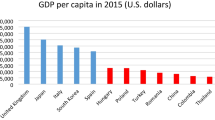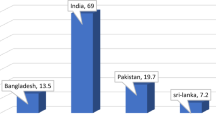Abstract
Using time series data from 1990–91 to 2011–12 and panel-data at 4-digit groups of NIC for the period 2008–09 to 2011–12 from the Annual Survey of Industries, this paper examines the argument that fall in employment is deeper in recession than the rise during boom, while fall and rise in output are of same intensity during recession and boom respectively. The result shows that the fall in both output and employment in Organized Manufacturing in India was sharper in downturns than their rise in upturns. Moreover, the decline in output decreases employment more than the employment created by a similar rise in output. For contract workers, the decline in jobs is even sharper in downturns than in upturns. During upturns, existing workers and skilled employees are used more intensively, and more jobs are created for skilled employees.
Similar content being viewed by others
Notes
The US employment rate contracts deeper and sharper during recessions than it expands in booms. See the studies referred to in Ferraro (2016).
Ferraro (2016) stated that unemployment-to-policy stimulus increases substantially during recessions.
Taken as the difference between total employees and workers.
Since the mean of a time series variable grows over time, calculating skewness coefficient at its level may overstate the negatives than the positives. Therefore, calculating the coefficient of skewness from the growth rate, which is a relatively stationary variable, gives a better picture.
Measured in Total Person Engaged
Interestingly, employment growth accelerated despite a slowdown in output in 1997–98 and 2008–09, the years crises broke out in, respectively, East Asia and the US.
References
Blanchard, O. and P. Diamond (1990), “The Cyclical Behavior of the Gross Flows of U.S. Workers”, Brookings Papers on Economic Activity, Vol. 1990, No. 2, pp 85–155, Also available at https://www.brookings.edu/wp-content/uploads/1990/06/1990b_bpea_blanchard_diamond_hall_murphy.pdf.
Bound, J. and H. Holzer (2000), “Demand Shifts, population adjustments, and labour market outcomes during the 1980s”, Journal of Labour Economics, Vol. 18, No. 1, pp. 20–54.
Bryan, M. and S. Longhi (2013), “Couples’ labour supply responses to job loss: boom and recession compared”, Working Paper No. 20, Institute for Social and Economic Research, Essex, UK.
Davis, Steven J. and John Haltiwanger (1990), “Gross Job Creation and Destruction: Microeconomic Evidence and Macroeconomic Implications”, in Olivier Jean Blanchard and Stanley Fischer (eds.), NBER Macroeconomics Annual 1990, National Bureau of Economic Research, Vol. 5, pp. 123–186
Fay, J.A. and J.L. Medoff (1985), “Labor and output over the business cycle: Some direct evidence”, American Economic Review, Vol. 75, No. 4, pp. 638–655.
Ferraro, D. (2016), “The Asymmetric Cyclical Behavior of the U.S. Labor Market”, Available at SSRN: https://ssrn.com/abstract=2848147.
Hall, R. (1980), “Employment fluctuation and wage rigidity”, Brookings Papers on Economic Activity, Vol. 1980, No. 1, Also Available at https://www.brookings.edu/bpea-articles/employment-fluctuations-and-wage-rigidity/.
Hamermesh, D.S. and G.A. Pfann (1996), “Adjustment Constant in Factor Demand”, Journal of Economic Literature, Vol. 34, No. 3, pp. 1264–1292.
Keynes, J.M. (1936), The General Theory of Employment, Interest and Money, Macmillan Cambridge University Press, Cambridge
Long, De J. Bradford and Lawrence H. Summers (1986), “Is Increased Price Flexibility Stabilizing?”, American Economic Review, Vol. 76, December, pp. 1138–54.
Mitchell, W.C. (1913), Business Cycles, University of California Press, Berkeley.
Mitchell, W.C. (1927), Business Cycles: The Problem and Its Setting, National Bureau of Economic Research, New York.
Morley, James and Jeremy Piger (2012), “The Asymmetric Business Cycle”, Review of Economics and Statistics, Vol. 94, No. 1, pp. 208–221.
Neftci, S.N. (1984), “Are Economic Time Series Asymmetric over the Business Cycle?” Journal of Political Economy, Vol. 92, No. 2, pp. 307–328.
Notowidigdo, M.J. (2011), “The Incidence of Local Labor Demand Shocks”, NBER Working Paper No. 17167, National Bureau of Economic Research, Inc., Cambridge, Massachusetts.
Sichel, D.E. (1989), “Are Business Cycles Asymmetric? A Correction”, Journal of Political Economy, Vol. 97, No. 5, pp. 1255–1260.
Author information
Authors and Affiliations
Corresponding author
Additional information
The views expressed in this paper are those of authors and not related to the Government of India.
Rights and permissions
About this article
Cite this article
Singh, J., Mitra, A. Cyclical asymmetries and short-run relation between employment and output: the case of organised manufacturing in India. Ind. J. Labour Econ. 59, 203–216 (2016). https://doi.org/10.1007/s41027-017-0055-6
Published:
Issue Date:
DOI: https://doi.org/10.1007/s41027-017-0055-6






